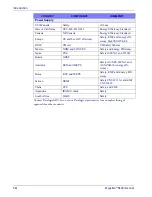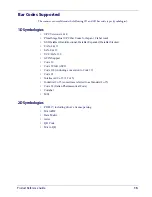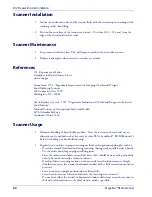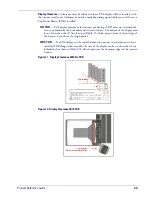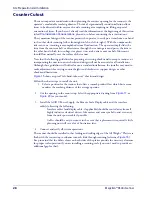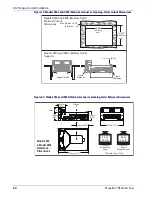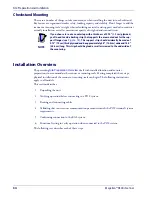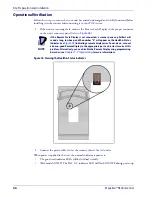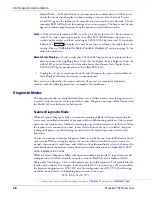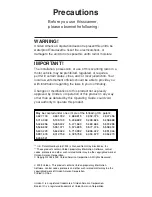
Product Reference Guide
23
Site Preparation Overview
Consider the following factors before installing the scanner/scanning-scale and its optional
Remote Scale Display.
Ventilation Requirements —
The scanner operates without the use of a ventilation fan. As long
as there is adequate convective air flow and no major heat producing equipment in close
proximity, the unit’s housing provides adequate heat dissipation. The air temperature in the
checkstand around the scanner must not exceed 104°F (40°C).
Service Access Requirements —
Routine operations such as ‘zeroing’ and calibration do not
require removal of the scanner from the checkstand or disassembly of the product. The installer
should plan service access for the AC/DC Power Supply and cables.
Recommended Power Installation —
Since the typical grocery environment includes conveyor
belts and electric motors, care should be taken to ensure that the scanner has a supply of “clean”
power (power without excessive electrical noise).
Counter Preparation —
Since the majority of grocery checkout lanes are designed as “left-hand
take away,” the counter drawings in this section focus on this counter design. Simply reverse the
layout for a “right-hand take away” requirement. The unit scans equally well in either of these
two configurations.
Liquid Drainage —
Should a liquid spill occur, ensure that moisture can flow through the
checkstand without pooling.
Leveling —
Plan ahead and provide screws/bolts in the checkstand mounts and a leveling guide
(board) to allow leveling of the scanner or scanning-scale within the counter. Use a 0.375” thick
board to replicate the mounting flange on the long scanner or scanning-scale, and adjust screws
or bolts until the board is flush within the counter. Use a 4.0” wide board stood on its end to
adjust leveling screws/bolts in rail support applications.
Cable Routing —
Placement of the scanning-scale should be planned to allow easy access to
other components as well as optimize communication between the scanner, the POS terminal
and the optional Remote Scale Display. Note that cables may drop straight down from the
scanner’s connector panel, or may be conveniently routed along the unit’s side using the
hardware provided. Do not route interface cables near any electrical motors or other sources of
electromagnetic interference.
Remote Scale Display Placement —
The customer, and checker in some instances, must be able
to easily view and read the Remote Scale Display (if one is present). Ambient light and
mounting height considerations are discussed later in this section.
Vertical Clearance —
Provision must be made to allow adequate space above the scanner bonnet
for removal and replacement of the All Weighs™ Platter (the L-shaped platter). Optimal
clearance permits the platter to be grasped at its top vertical edge and lifted for removal without
obstruction (such as a fixed keyboard mount or any type of enclosure). Should such an
enclosure be unavoidable, an alternate method of platter removal using two coins may be
employed, however a minimum vertical clearance of 1.5” (3.8 cm) MUST be provided
(reference
). Another consideration is that the scan zone must be kept free of
obstructions such as enclosures, keyboard mounts, etc.
Summary of Contents for Magellan 9800i
Page 1: ...MagellanTM 9800i Product Reference Guide...
Page 62: ...Site Preparation and Installation 50 Magellan 9800i Scanner NOTES...
Page 102: ...Calibration Procedures 90 Magellan 9800i Scanner NOTES...
Page 112: ...Programming 100 Magellan 9800i Scanner NOTES...
Page 158: ...Enter Exit Programming Mode 146 Magellan 9800i Scanner NOTES...
Page 174: ...EAS Features 162 Magellan 9800i Scanner NOTES...
Page 378: ...Enter Exit Programming Mode 366 Magellan 9800i Scanner NOTES...
Page 400: ...2D Symbology Programming 388 Magellan 9800i Scanner NOTES...
Page 414: ...402 Magellan 9800i Scanner NOTES...
Page 424: ...412 Magellan 9800i Scanner NOTES...
Page 438: ...426 Magellan 9800i Scanner NOTES...
Page 450: ...438 Magellan 9800i Scanner NOTES...






